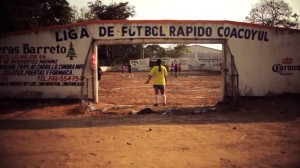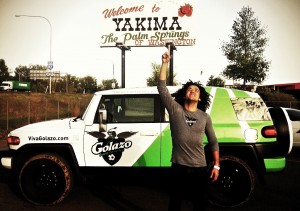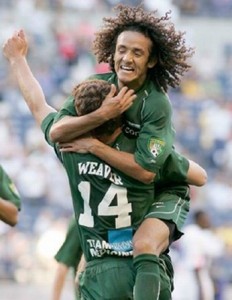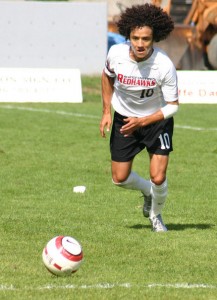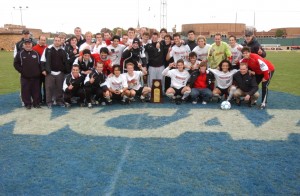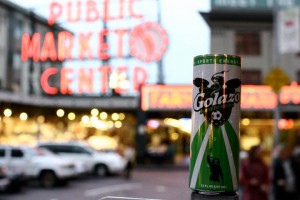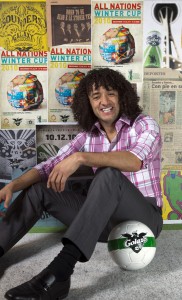A game worth living for: Santa Maria Rivera’s story
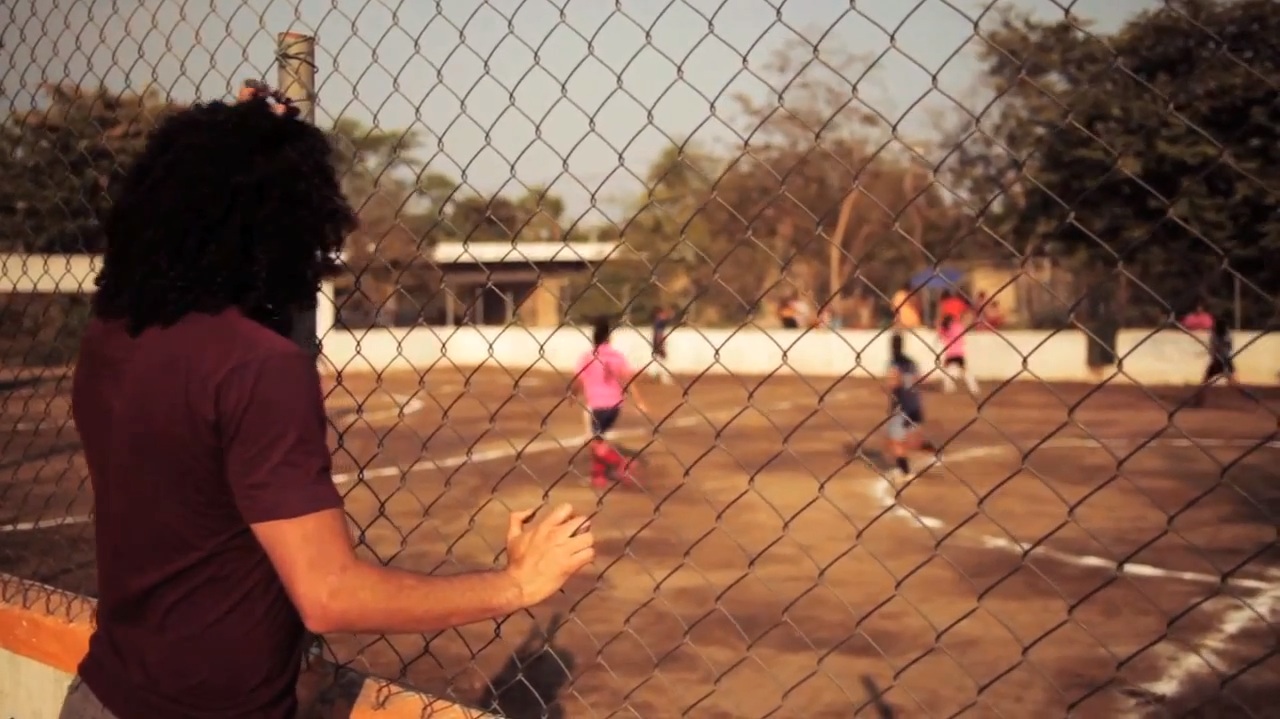
The third time Santa Maria Rivera crossed the border illegally, he was 12 years old. It would be the last time.
Rivera and his family were in Nogales, Mexico, shortly after meeting with American authorities in Ciudad Juárez. They were rejected entry to the United States because his father did not make enough money to support a young family of five. After an overnight bus ride from Juárez to Nogales, they plotted their next move.
The date was June 19, 1994, during the World Cup hosted across the border. The Riveras — father Leoncio, mother Maria Isabel, 12-year-old Santa Maria, 7-year-old Maria Guadalupe and 11-month-old Irving Alonzo — walked along the 12-foot-high wall separating Mexico from Arizona. At a taco stand, Santa Maria watched Mexico play Norway on a square television with rabbit ears as he enjoyed his tacos al pastor, expecting a Mexican victory.
Norway pulled out a 1-0 win on an 84th-minute goal from Kjetil Rekdal, and the Rivera family hobbled back toward their motel, dejected. The wall separating the two nations loomed large as it cast its late-afternoon shadow. The glow of dusk bathed the town in orange light, the air thick with dust kicked up by pedestrians.
Then, they saw it.
A swarm of people surrounded a section of the chiefly wooden wall like bees crowding a hive. One at a time, they disappeared. The opening was wide enough for one person at a time. With anticipatory shoves from behind, one after another squeezed through the tiny hole in the wall.
Immigration and Naturalization Service officials had vanished, possibly a 5 p.m. shift change gone awry. The Rivera parents looked at one another, and they knew they had to go. They ushered their two able-bodied children toward America, and Leoncio carried their infant son, leaving every possession they had at the hotel.
Dashing four city blocks with pace normally reserved for blowing past opponents on the soccer field, Santa Maria was once again in the United States. This time, he and his family planned to stay. They ran to a McDonald’s just across the border, away from life in Mexico.
* * *
Leoncio and Maria Rivera lived double lives in the 1980s. Each spring, they crossed into the U.S. to work the fields, picking fruit to support the family waiting for their return. They left from March to October, in California’s Central Valley and Yakima Valley in Washington.
Leoncio became an American resident in the mid-1980s, under the Immigration Reform and Control Act of 1986 that became known as Ronald Reagan’s amnesty act. Security at the Mexican border increased, as did penalties for companies that knowingly employed illegal aliens, but continuous residents who entered before 1982 were granted legal status. Leoncio was one of about 3 million sheltered under the Act, but Maria continued to work illegally.
They often stayed with one of Leoncio’s siblings, most of who lived in the United States. He was one of 11 children, and only three still lived in Mexico. He established a network of places they could live and orchards where they could find work throughout California and Washington, moving north as the seasons changed.
The children stayed with Leoncio’s parents in the coastal resort town of Ixtapa-Zihuatanejo, 300 miles southwest of Mexico City. Santa Maria was the oldest child, named after his grandfather. His father absent for half the year, he clung to soccer. He had energy to burn, and he loved the game.
Leoncio’s sister married a man known as Chelís. Everybody in Mexico has a nickname; Chelís got his from a combination of his two proper first names: José Luis. He coached every youth team in the 7,000-resident town of El Coacoyul, just outside Zihua. Mexican youth soccer has two age groups: infantil, which includes children of all ages up to 12, and juvenil, which goes up to 16. Rivera played with all his teams, and Chelís let him play all 90 minutes.
He played with children twice his age and older, on fields like indoor soccer facilities in the U.S. — goals set into boards that curved around the outside of the field and enclosed it in an oval — but with a dirt playing surface. White lines on the clay playing field faded as players trampled around, kicking up dust along with a patchy soccer ball. During rainy season in late summer, the entire pitch turned to mud.
Rivera learned quickly that he could not rely on physical play against players twice his size. Soft knees were bloodied from the harsh surface, older players mercilessly tackling younger ones. Hagan piernas, they say — “make legs” — or you will not survive.
“I was never the best player on the team,” Rivera, 31, says today. “There were players that were far better than me, but I just had a knack for it. I had a passion for it, but at the same time, I had another thing that a lot of kids in Mexico don’t have — and that is drive.”
Chelís coached every player in town, watching over them as they found their way through the Mexican soccer gauntlet. His high energy and quick jokes resonated with children of all ages, and they respected his knowledge and passion. He walked on crutches, paralyzed from the waist down. His injury resulted from a gunshot to the spine sustained during a robbery at the gas station where he and his younger brother worked.
Still, he coached and worked. He crutched up and down the sidelines, and during the week, he crutched around town to collect money for the water company. Customers did not receive paper bills; they got a knock on the door from a collector instead. Chelís was that collector, and it took him all day to get to every house in town. Rivera went with him on a couple rounds in 100-degree heat.
When he died of kidney and liver failure in 1999, the entire town showed up to his funeral.
By that time, Rivera was long gone.
* * *
Hearts racing from their hastily executed crossing, the Riveras sat in the McDonald’s in Nogales, Ariz. It didn’t take long to attract attention.
“Psst, psst. Psst, psst. You guys need a ride?”
“Yeah. How much?”
“I’ll take you to Chandler for $200 apiece.”
Having crossed the border with nothing but the clothes they wore, the family did not have the money. But the stranger agreed to give Leoncio a short time to come up with it. They piled into his two-door sedan for the three-hour drive to the Phoenix suburb.
The previous time Santa Maria crossed the border, at age 9, was also in Arizona, with his father and 8-year-old cousin. Leoncio noticed that Mexican-Americans would cross the border to shop in Arizona, and a group of Mexican street kids would run across to help them carry bags to their cars, hoping for a nominal tip. INS officials turned a blind eye out of pity.
Leoncio drove across the border in his van, green card in hand, and kept going for three blocks. Santa Maria and his cousin ran across with a group of children, seemingly to help somebody load up their car. But they kept running. They kept their heads down — no looking back. They sprinted to the van, climbed in and sped off. Maria crossed the border through a hole in the wall on the other side of town, and they met up and headed north.
Two years prior, the Riveras walked from Tijuana to San Diego all night, through the brush. Helicopters circled overhead, and the coyote leading them as they crossed instructed them to dive into the tall grass and hide at first sign of any spotlights. At age 7 and with the movie “Rambo” on his mind, Santa Maria couldn’t help but look.
He was Rambo. He could make it.
Once he was in the U.S., Santa Maria worked alongside his parents, particularly assisting his father with his side business — dealing drugs. His father took him on runs to deliver cocaine. He shoved bags of coke in Santa Maria’s underwear in case the police pulled them over, thinking they would not search a 7-year-old boy. When they reached the delivery point, Leoncio knocked on the door, reached into his son’s boxers to pull out the drugs, took the money and moved on to the next house.
Being a drug mule was nothing new for the young boy. In Mexico, Santa Maria helped his father package marijuana into blocks, which Leoncio and his cousins sold.
“I guess you could say I was one of the youngest drug dealers in Yakima,” Santa Maria says. “My mother hated it. She won’t ever forgive him for putting me in that situation.”
In his first few permanent days in America, Santa Maria watched the World Cup in Chandler, sheltered by a family of Mexican immigrants to whom his own family was indebted — literally and figuratively. He marveled at Brazil’s Romário, the Golden Ball winner who comprised the unstoppable strike partnership with Bebeto that led Brazil to its fourth world championship that year.
After a week, Leoncio paid his debt to the stranger, and his family rode a Greyhound bus from Phoenix to Los Angeles. They stayed with one of his sisters for two weeks, until they could afford a two-door, black Subaru for $300. Santa Maria was enthralled with the power windows, irritating his father by repeatedly pushing the button to propel the window up and down, up and down. The car also had a modified muffler, its noise tearing through the air throughout the 1,000-mile drive north to Yakima, Wash.
“I had never seen power windows in my life. The whole trip from L.A. to Yakima, I got in so much trouble because I was rrrt-rrrt,” he says, pantomiming himself as a kid, flipping the switch back and forth, head following the imaginary window momentarily before he breaks into laughter.
They moved in with one of Leoncio’s sisters in Yakima. Living room floors were a staple of Santa Maria’s early experiences in America. He slept in makeshift beds until his parents earned enough money to rent their own place, such as the one-room shack in an orchard in the Tieton highlands of Yakima — complete with an outhouse — that served as one Rivera household.
Santa Maria received his green card not long after moving to the U.S. permanently, in 1995. In 1996, Maria and Leoncio bought the only American house they would own.
Maria still lives in the cramped two-bedroom house with a lush green lawn. She tried to grow flowers, but Santa Maria knocked them over every summer with a soccer ball, training for his action with the Sun City Strikers club and Eisenhower High School.
Yakima’s population still fluctuates annually, as migrant workers flow in and out of the valley, but the border is more difficult to cross now. Rivera went to school with many children who barely spoke English. They played soccer in the school courtyard. In middle school, they nicknamed Rivera “Pelé” for his skill, despite his diminutive stature. He stood out for his speed, excellent touch and poufy black curls reminiscent of Carlos Valderrama’s blonde semi-Afro.
“Those were the kids in middle school — you knew who they were because they were the only ones playing soccer,” he says. “The brown kids, playing soccer.”
At home, Rivera’s family spoke Spanish and remained steadfastly Mexican in their morals and values. Maria strove to maintain old traditions in her transplanted children (“She’s very prideful of: this is where I’m from, this is who we are, this is what we’re about, this is how we eat and this is who we pray to,” her oldest son says), even as she gave birth to a second baby girl, whom she named Britney Elizabeth. Leoncio supported the family any way he could, continuing to deal drugs despite Maria’s protests.
Santa Maria stayed away from drugs himself, partly at his mother’s insistence and partly because he loved to play. He became the first member of his family to graduate from high school. He had a scholarship offer from Columbia Basin College, a two-year school in nearby Pasco, but big-time schools did not see much in the small 17-year-old. He stood 5 feet, 7 inches tall and weighed 130 pounds. When the colleges stayed away, he made other plans.
However, Santa Maria promised his parents that he would eventually return to get a college degree. Today, he recalls his mother’s insistence that he take advantage of the opportunity for education that no one else in his family had.
Santa Maria graduated from high school June 10, 1999, and he began picking cherries to pay for a bus ticket. On Independence Day, he took a Greyhound to Tijuana, where he bought a plane ticket on the spot to complete his trip to Morelia. After five years, Santa Maria Rivera was back in Mexico.
* * *
Tryouts for Club Atlético Monarcas Morelia lasted three weeks. The club held training sessions at its complex of about 20 fields. In typical Mexican fashion, the playing surface was not grass or artificial turf. Rivera had not played on dirt since he left Mexico in 1994.
After each week of training, coaches called out a list of assigned player numbers — the list of players cut. One week went by, and Rivera played. Two weeks went by. Rivera got caught up in training from 8 to 10 a.m. and 4 to 6 p.m. He enjoyed spending all day with a ball at his feet. In the third week of tryouts, only about 75 players remained to compete for 40 roster spots. Rivera continued to shine, showing deft ability on the ball and a competitive mentality cultivated north of the border. Winning excited him, and the coaching staff took notice.
“One thing that I brought from America down to Mexico was that competitive spirit of, ‘I’m going to win every run. Every single sprint that we do, I’m going to be first. Every single time.’ Typical American, right?” he says. “I’m going to finish first every single time. Which is something that Mexican people, they don’t have that in them. They just don’t. They’re just content with doing the runs. ‘There. I did it. Done.’ ”
After three weeks, they presented him with a contract. The offer was on the table, but it might disappear by the next day. Quickly weighing his options, he signed a one-year deal on the spot. For a year, Rivera woke up at 6 a.m. to make the hour-long commute to Morelia’s training grounds and play on the club’s third-division team.
At the end of the first season, Rivera moved up to Morelia’s second-division team. He grew three inches and put on 20 pounds. He was the second-youngest player on the Under-23 team. In a return to his younger playing days, he competed with players five years older than him who had played on the team since they were his age.
Rivera is a lifelong Chivas fan, and even playing for Morelia could not change that. His uncle’s best friend was Mexican soccer legend José Manuel “Chepo” de la Torre’s brother, the only one of his family who did not play.
“Funny story: I saw El Chepo de la Torre’s sister in her lingerie because she was so drunk,” Rivera recalls, laughing heartily at the memory. “Long story short, I went to his parents’ house to go collect tickets for Chivas de Guadalajara. I went to go see them when they played in Estadio Jalisco.
“Anyways, I’ll rewind.”
Closer to reaching his potential as a player, Rivera left Morelia after his second season, making good on his promise to his parents and abruptly walking away from his steady path toward the Morelia first team. He began looking for opportunities to go back to school in the U.S. In the meantime, he signed for the Yakima Reds in the amateur Premier Development League.
The Reds played at Marquette Stadium, which looked like something Rivera just left behind in Mexico. The benches were on one side of the field, and one concrete stand stretched the length of the far sideline, holding up to 1,500 people. It towered over a grass field full of holes and bald patches, complete with solid-iron goals that would yield to nothing and nobody flying toward them.
During preseason 2001, the Reds hosted the USL First Division (second-tier professional) Seattle Sounders, losing 3-2 behind two goals from Rivera. A capacity crowd packed Marquette to see its hometown team battle the state’s only pro club, including Nelson Zaldivar, the Wenatchee Valley College head coach. After the game, he found Rivera walking off the field.
“Are you going to school somewhere?”
“No.”
“Do you want to go to school?”
“I’d love to go to school. But can I ask my mother first?”
* * *
Maria Isabel Rivera left work at the apple warehouse in Cowiche, in the Yakima highlands, in early June 2002, driving her baby blue Dodge Acclaim down Summitview Road. She failed to notice the burgundy Ford Explorer following closely behind, although she saw that car often. Shortly up the road, the trailing car sprung into action. It swerved in front of Maria’s car. It cut her off and forced her off the road.
Leoncio Rivera got out of his car, punching through the driver’s side window of Maria’s car. He pulled her out through the broken glass and beat her.
Santa Maria picked up his ringing cell phone, frowning at the strange number on the caller ID. His mother responded from the Yakima Valley Memorial Hospital.
“M’ijo, I know you have a game. Come see me afterward, please.”
“What? I’ve got to go now.”
“No. You’ve got to go play. I know how much this means to you.”
Rivera respected his mother’s wishes. The Yakima Reds tied the Seattle Sounders Select PDL team, 2-2, behind two more of his goals. He told a coach what happened, and he drove Rivera directly to the hospital after the game to see his mother.
At the time, Santa Maria’s parents were locked in a brutal divorce process. Leoncio’s affinity for booze and drugs drove Maria to break off their marriage. Leoncio did not take disappointment lightly. The fair-skinned, attractive child of his family, he was used to working his way out of any tight situation with practical intelligence. He could listen to any tune and play it back on guitar without any coaching. When he could not think his way out, he became frustrated and violent.
Leoncio was deported, but not before Santa Maria ran into him one last time. Luckily for both parties, they were not alone. Family bystanders pulled Santa Maria off his father, taking his hands from around Leoncio’s throat. It was one of the last times they spoke.
As the family struggled at home, Santa Maria’s life on the field flourished.
After a 24-goal, 24-assist season at Wenatchee Valley College, three universities sought his services. In a game against Peninsula College his freshman year, Rivera scored all five goals in a 5-0 rout. Coaches from Western Washington University, Concordia University and Seattle University all courted him. Concordia’s Dan Birkey drove from Portland to Yakima on Christmas Eve with paperwork for Santa Maria to sign.
But on his visit to Capitol Hill, Rivera found Seattle University mesmerizing. Head coach Pete Fewing impressed him, and the allure of a $50,000-a-year Jesuit school just uphill from downtown Seattle was irresistible. Rivera was ready to sign, but Fewing never got back in touch.
In preseason 2002, the Sounders made another trip to Yakima. With Herculez Gomez, Brian Ching, Leighton O’Brien and Preston Burpo on the field and Brian Schmetzer behind the bench, they lost 1-0 to the unruly Yakima kids who worked in warehouses and played in Mexican leagues.
Rivera scored the winner, on a penalty kick.
“This is kind of destiny, the stuff of movies,” he says.
In a scene similar to the first time he was recruited, Schmetzer approached him.
“Are you going to school anywhere?”
“I’m talking to a couple schools. I’m talking to Western. I’m talking to Seattle University—”
“You’re talking to Pete? Have you signed yet?”
“No.”
Schmetzer pulled out his cell phone, dialed a number and waited.
“Hey, Pete. It’s Brian here. I have Santa Maria here with me. Are you going to sign him? Or can I sign him?”
Within 24 hours, he signed and faxed his paperwork to the Seattle University Department of Athletics.
* * *
Four minutes remained in the game — in Seattle University’s season. The Redhawks trailed Dowling College 1-0 since the fifth minute, when goalkeeper Jeremiah Doyle slipped as he dove to his right side, unable to keep Chris Kenney’s shot out. The No. 1-ranked team in the nation trailed for only the second time all year.
As the clock ticked down, Seattle took a throw-in on the right flank. Andy Stromberg floated a cross that the goalkeeper mishandled, dropping to Adam Jensen on the back post. He tapped it in, and the crowd swelled to a roar.
Seattle had 20 wins and one tie heading into the 2004 NCAA Division II Final Four in Wichita Falls, Texas, where it came up against Dowling. Southern Illinois-Edwardsville waited for the winner of the second semifinal, having smashed North Carolina-Pembroke 4-1 in the first match of the evening on Dec. 3.
Santa Maria Rivera had been largely absent from run-of-play scoring all year. Head coach Pete Fewing moved the redshirt junior from wide midfield to central defense because of an injury to the usual sweeper, and although Rivera struggled to adapt at first (he was used to tearing past defenders, big hair bouncing with every stride, and playing incisive passes behind the back line with his left foot), his foot skills became a catalyst for springing attacks out of the back.
In overtime, Rivera watched as forward Cam Weaver (who now plays for the Houston Dynamo), launched a long throw-in toward the top of the Dowling penalty area. Alex Chursky controlled the ball, laying it off to All-American and University of Washington transfer Bobby McAlister, whose laser beam of a right-footed shot tore through the air.
It smacked the side netting inside the far post, rippling the net outward.
As the pro-Seattle crowd — at least 100 alumni made the trip to watch their team — roared again, the team rushed toward McAlister. Except Rivera. He looked over at the bench, catching eyes with his head coach. They ran toward each other like two lovers on a TV show, embracing near the center circle.
Rivera and Fewing jumped jubilantly, still hugging, and they started to spin around in circles. Jumping, spinning, jumping, spinning — all the way across the field, where they fell in a daze in front of the stand at Midwestern State University’s stadium. It was a definitive moment in a relationship that almost did not transpire, had it not been for a well-timed call from the Sounders coach.
“The day that I get married, if it ever happens, he’s going to be with my mom, walking me down the aisle,” Rivera says of his college coach. “The best way that I can put it: he gave me the keys to my future by taking a chance.”
Fewing embraced the energetic Mexican from the moment he stepped on campus. The 20-year college coaching veteran measures his words carefully. A steadfast professional, Fewing takes a moment before answering interview questions, a smile playing at the corner of his mouth when he talks about Rivera. Rivera calls Fewing profe, the traditional Mexican address toward a coach that literally means “professor.”
Fewing provides analysis for Seattle Sounders FC television broadcasts along with coaching at Seattle University, which he did from 1988 to 2006 before leaving the school to win a PDL national championship with the Kitsap Pumas in 2011. He returned in 2012 for a second stint with the Redhawks. He co-authored a book in 2010 titled “Coaching Principles for the Development of Championship Teams: On and Beyond the Pitch.”
Rivera consistently tested Fewing’s leadership ability, such as when a referee failed to show up for a match and a Seattle assistant coach took up the whistle. Rivera seethed at a perceived miscall, and he told the coach-referee how he felt. Ultimately, Fewing had to pull Rivera from the match. The player’s focus would not yield for his own coach refereeing a match.
“The guy refereeing was an Army Ranger and a West Point graduate. He’s a very accountable guy, and he does a good job. So here he is refereeing, and Santa starts getting in it with him,” Fewing says. “We had to yank Santa out, but that’s Santa. He’s all in, all the time.”
Rivera completed the Cooper test (the classic soccer fitness test that entails completing a two-mile run in under 12 minutes) in 10 minutes, 42 seconds, “and he was just coasting,” Fewing says. He brought a classic Latino bite to training sessions, tackling his teammates as ferociously as he did opponents on match day and shouting furiously at players who misplayed passes.
Fewing’s message that training should be tougher than games resonated with his new recruit. On more than one occasion, Fewing tried to calm down the team’s firecracker, just before Rivera heedlessly launched into another two-footed tackle. In the attack, he worked combinations down the flank, weaving through defenders like traffic cones.
“That competitive spirit, it’s from my mother because she’s always been all in,” Rivera says. “She’s been able to raise four children, four kids on her own and not one day complaining, ever. She’s been all in, all the time. She’s always my inspiration.”
When he moved to sweeper, he still took the team’s set pieces. In the 2004 final against Edwardsville on a windy day, he served a ball into the box from 45 yards out that ended up in the back of the net. Seattle won the final 2-1, and Rivera won the award for Most Outstanding Defensive Player of the Final Four. The Redhawks won 22 games and tied one, becoming the ninth Division II team to finish the season as undefeated national champions.
Rivera framed his red jersey from the championship game and gave it to his mother. It hangs on her living room wall, along with photos of her son in action.
As he transitioned to life in Seattle, Yakima continued to offer reminders of what he escaped. Just two blocks from his mother’s house, a childhood friend with whom Rivera played club soccer was shot in the head, execution style. At the time, Rivera lived in the dorms at a Jesuit college, playing for a championship soccer program. He had moved on.
Today, Rivera cannot even remember that friend’s name. “I don’t think it changed anything, honestly. Was it painful? Was it hurtful? Absolutely,” he says, “but by then, I already knew what I wanted. I knew where I wanted my life to go.”
Most players from Seattle University’s 2004 team got a chance at the next level. Rivera tried out with Chivas USA and the Seattle Sounders. He and Cam Weaver signed with their local team, and Rivera played for two years. His professional career never really took off, and he played just 600 minutes in 2006 and 2007. As a fringe player on a USL First Division team, Rivera worked three other jobs to make ends meet.
He worked construction from 6 a.m. to noon, trained with the Sounders from 1 to 3:30 p.m., coached a high school team from 4:30 to 6 p.m. and worked as a bartender’s assistant from 6:30 to 11 p.m. On the field, his team won the 2007 USL championship. Off the field, he struggled to find time for himself among his commitments.
“I loved it. I have great memories,” he says. “I have pictures I can show my kids to prove, but in terms of the level of professionalism, in terms of money, it just wasn’t there.”
Rivera got to play against his hero from the 1994 World Cup, Romário, when the aging star played for Miami FC in USL-1. Rivera came on as a substitute, sprinting directly toward Romário to mark him on a corner kick. Rivera recalls grabbing him by the hip, whispering in his ear: “You’re my idol. I just want you to know that.”
The 39-year-old World Cup veteran and Golden Ball winner turned to Rivera, gently slapping his cheek with an open palm. “Oh, pibe.”
Seattle lost the match 3-2. Romário scored a hat trick.
* * *
In 2010, Rivera joined energy drink company Golazo, a Seattle start-up focused on soccer and community outreach. Rivera’s face is forever stamped on the early cans of the beverage, his signature hairstyle topping his silhouette, one arm stretched toward the sky (or maybe the Golazo logo on the can). He spoke at schools, telling his story of how soccer shaped his life and changed his path, hoping to inspire other at-risk children to rise above their environment.
He symbolized a company fully ingrained in soccer culture that wanted to get in touch with its Latino roots (golazo in Spanish means “great goal”). The company made a 20-minute documentary of Rivera’s story. “A Most Improbable Life,” available on YouTube, follows him as he coaches his FC Alliance club team and visits his mother’s house in Yakima, his family home in Zihuatanejo, the spot in Tijuana where they crossed the border and his father in Lázaro Cárdenas, just outside Mexico City.
Now, Rivera works for Redapt, Inc., leading its Business Development and Minority Outreach Program.
In April 2013, he received Seattle University’s Outstanding Recent Alumnus Award. In another lifetime from the one described in the documentary, he stared out from the stage of Campion Ballroom on his old campus. He saw important men and women in fancy dresses and suits. Fresh off shaking university president Father Stephen Sundborg’s hand, glass award resting next to him on the lectern, Rivera spoke once again about his experiences — this time, in front of a new audience, none of whom lived the life he did growing up.
“I had never heard of alumni awards up until I received the call. I thought it was a prank call from one of my buddies. All the work that I did with Golazo, all the school presentations and all the community outreach that we did,” he says, “I never did it expecting anything in return. I did it because it was the right thing to do and because after I was done playing, I did embrace that role-model [idea of the] Mexican kid who came out of a small town, went to college, graduated, played professional — I’ve embraced it.
“It took me a while to embrace it. I wasn’t really quite happy with that tag. Now, I realize that Chicano-Latino kids, they need people like myself. As I get older, I realize that it’s OK. You are maybe inspiring a handful of kids to go on and do bigger things than you did.”
Fewing says: “I think it’s opened his eyes. The experience was meaningful, and he did a great job with the speech and thanking everybody, and he recognizes that he’s a role model. He realizes it, and he realizes that he can help people. I like the fact that he thinks that way and that he’s trying to figure out how he can.”
Rivera spoke not about himself or his achievements as he accepted his award, but about his mother.
“That evening, it was more for my family,” he says. “The way I saw it, it was more of a ‘Mother, thank you for everything. This is your reward for raising us four, and this is the good that has come of it for all your hard work, from always being all in. This is not about me, it’s about you, Mom.’ That’s kind of how I felt it, [but] was I incredibly proud being the first Mexican kid to win the award? Absolutely. First soccer player to win that award? Absolutely. It’s the little things.
“But most importantly, I see it as another opportunity to keep pursuing what I know my passion is now, which is giving back to the community, being a man of service. That’s what I really want to focus on this next stage of my life: being able to inspire the next little Mexican-American kid from Mattawa, from Richland, from Kennewick, from Walla Walla, from Kent, from Burien, that it’s OK to dream big. It’s OK to stay disciplined and have your buddies laugh at you because you’re not going to go party on a Friday night. It’s OK to walk around with a soccer ball at your feet in class in high school.”
Now, Rivera is working on his paperwork to become a U.S. citizen. He says he wants to work for the Bill and Melinda Gates Foundation, empowering people to reach their full potential. Sheepishly, he adds, “This might get me in trouble with my current job.”
But his former coach says that kind of ambition is what Rivera’s life will require.
“I’m proud of him for thinking that way. He knows he’s not just going to go through life and coast or just have a job,” Fewing says. “He’s going to have to be Santa Maria Rivera, which he’s kind of built without trying, his own sort of brand.”
After living a textured life for 31 years, it is difficult to imagine the pinnacle is yet to come. But Rivera insists that everything to this point prepared him for his ultimate purpose in life.
“Especially when I walked up to the stage,” he says, “[and] I saw all these super-powerful and influential people, that’s when it hit me even more that I need to continue, that this is just the beginning. It’s just the start. It’s not the end.”

